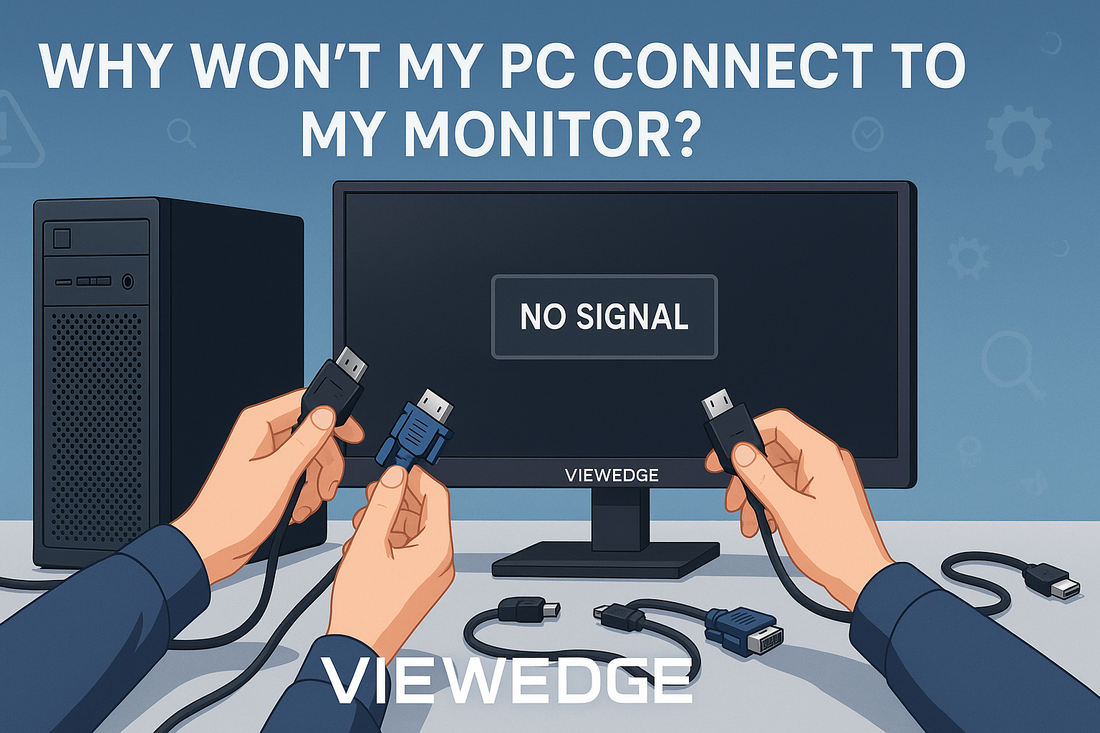
Why Won’t My PC Connect to My Monitor?
Share
It’s a frustrating moment—your PC is on, but the monitor shows nothing. Whether you’re setting up a new system or your display suddenly went black, figuring out why your PC won’t connect to your monitor can be tricky. Fortunately, most connection issues have simple causes and quick solutions.
This guide will walk you through the most common reasons your PC might not connect to your monitor and how to fix them step by step.
Check Physical Connections First
The most common reason your monitor isn’t displaying anything is a loose or faulty cable.
Check the Cable Type and Condition
Make sure you’re using a compatible video cable, such as HDMI, DisplayPort, DVI, or VGA. Sometimes cables wear out or develop hidden faults. Unplug and re-plug the cable firmly on both ends. If possible, try using a different cable to rule out cable damage.
Inspect the Ports
Look closely at the video ports on both the PC and the monitor. Dust, bent pins, or a loose port connection can prevent the signal from getting through. Try plugging the cable into a different port if your PC and monitor have more than one option.
Select the Correct Input Source
Most monitors don’t automatically switch inputs. If your monitor is set to HDMI 1 but your PC is connected to HDMI 2 or DisplayPort, the screen will stay black.
Use the monitor’s on-screen menu (OSD) to select the correct input source that matches your cable connection. This simple step is often overlooked but can instantly solve the problem.
Check Your PC’s Display Settings
If your PC is on but you see nothing on the screen, the system might be sending the signal to a different display or using the wrong output settings.
Try Windows Key + P
On Windows PCs, pressing Windows + P opens display modes. Make sure the setting is not set to “Second screen only” if you are using just one monitor. Try switching between modes like “Duplicate” or “Extend” to see if the display returns.
Resolution and Refresh Rate Mismatch
If your PC is set to a screen resolution or refresh rate that your monitor doesn’t support, it might refuse to display anything. You can try booting into Safe Mode to reset display settings to a lower resolution.
Update or Reinstall Graphics Drivers
Outdated or corrupted graphics drivers can prevent proper communication between your PC and monitor.
Check for driver updates from your graphics card manufacturer. If necessary, boot into Safe Mode and uninstall your current drivers, then reinstall the correct ones for your graphics card.
Check Hardware Components
Graphics Card Seating
If you’re using a desktop PC with a separate graphics card, it may have become loose over time. Carefully reseat the card inside the motherboard and ensure all power cables are connected.
Monitor Compatibility
Older monitors may not fully support newer graphics cards or resolutions. If your monitor has firmware updates available from the manufacturer, installing them can sometimes solve detection problems.
Test Other Devices
Connect your PC to another monitor or TV to see if the problem is with your PC or the monitor. Likewise, try connecting your current monitor to a different computer. This quick test can save you time by isolating the issue.
Advanced Troubleshooting
Check BIOS/UEFI Settings
Some systems prioritize integrated graphics over a discrete GPU by default. Check your BIOS or UEFI settings to ensure the correct display output is selected.
Safe Mode or Low Resolution Mode
Booting into Safe Mode with minimal graphics settings can help reset display configurations that prevent the monitor from working.
Reset Monitor to Factory Defaults
Use the monitor’s on-screen menu to restore factory settings in case a previous configuration is blocking the signal.
When to Seek Professional Help
If you’ve tested the cables, ports, drivers, and tried another display without success, the issue may be hardware-related. Possible causes include GPU failure, motherboard problems, or power supply issues.
At this point, it’s best to contact technical support or take your PC to a qualified technician for a detailed inspection.
Conclusion
When your PC won’t connect to your monitor, the issue is often simple: a loose cable, the wrong input source, or incorrect display settings. Working through these solutions step by step—from checking cables to updating drivers—can quickly restore your screen.
Taking a calm, methodical approach usually solves the problem without needing professional repairs.
More Thought:
24 vs 27 Inch Monitor: Which Should You Choose?
